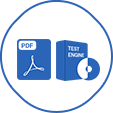Last Update 1 day ago Total Questions : 138
The WGU Scripting and Programming Foundations Exam content is now fully updated, with all current exam questions added 1 day ago. Deciding to include Scripting-and-Programming-Foundations practice exam questions in your study plan goes far beyond basic test preparation.
You'll find that our Scripting-and-Programming-Foundations exam questions frequently feature detailed scenarios and practical problem-solving exercises that directly mirror industry challenges. Engaging with these Scripting-and-Programming-Foundations sample sets allows you to effectively manage your time and pace yourself, giving you the ability to finish any WGU Scripting and Programming Foundations Exam practice test comfortably within the allotted time.
A software team has been commissioned to create an animation application. Which event takes place during the analysis phase in the Agile approach?
A software developer determines the mathematical operations that a calculator program should support When two waterfall approach phases are involved?
What is a characteristic of an interpreted language?
An algorithm should output "OK" if a number is between 98.3 and 98.9, else the output is "Not OK." Which test is a valid test of the algorithm?
Which two statements describe advantages to using programming libraries?
A function should determine the average of x and y. What should be the function's parameters and return value(s)?
An algorithm should output ‘’OK’’ if a number is between 98.3 and 98.9, else the output is ‘’Net OK’’
Which test is a valid test of the algorithm?

